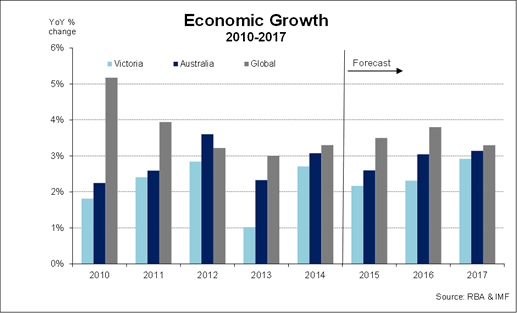Economic Outlook 2015
January 22nd 2015 | , Urban Property Australia
Even with the sharp oil price decline - a net positive for global growth - the world economic outlook is still subdued, weighed down by underlying weakness elsewhere.
Global Economic Outlook
Global growth remained slightly below trend last year at around 3.3% but is expected to pick up to 3.5% in 2015 and 3.8% in 2016. Major differences in the strength of economic activity persist between regions with the US, India and China accounting for almost 2 percentage points of forecast global growth. In contrast, headwinds to economic growth remain in the Euro-zone, Japan, Russia and Brazil.
The Chinese economy hit its lowest annual growth rate since 1990 last year – 7.4% and will slow further over the next two years, according to the International Monetary Fund. It is the first time the Chinese government, which aimed for 7.5% growth, has missed a target since 1998 when the economy was buffeted by the Asian financial crisis. The IMF now expects Chinese growth of 6.8% this year, before falling to 6.3% in 2016.
While China’s economic slowdown remains a risk to global growth, lower energy prices may help boost consumer spending and sentiment in the region which is likely to help smooth China’s economic slowdown.
Oil prices are already down more than 50% since the middle of 2014, a function of increasing supply (particularly US domestically) and reducing demand (weak global economic growth), exacerbated by OPEC’s decision in November not to cut production.
Surprisingly, the IMF upgraded growth expectations for the United States. It was the only major economy upgraded by the IMF in its latest report, which now expects growth of 3.6% this year and 3.3% in 2016 – an upward revision of 0.5 percentage points and 0.3 percentage points respectively.
Lower oil prices are also likely to boost activity in India but dampen growth in the many energy exporting economies.
India is forecast to overtake China as the world’s fastest growing major economy next year, according to the IMF with India forecast to grow at 6.5% in 2016, versus 6.3% for China. In India weaker external demand is forecast to be offset by the boost to the terms of trade from lower oil prices and a pickup in industrial and investment activity after policy reforms.
India’s solid economic growth is likely to result in increasing demand for Australian resources to meet infrastructure needs and the Modi government’s focus on lifting the productivity of services and manufacturers will raise opportunities for foreign suppliers.
Australian Economic Outlook
While lower oil prices would present difficulties for Australia’s energy exporters, especially the liquefied natural gas industry, there is likely to be a net benefit to households and the broader Australian economy.
For Australia’s key export markets, lower oil – and energy prices, more generally – will have an outsized and positive effect on their economies compared to others in the world. The top four destinations for Australia’s exports, accounting for 60% of the goods and services sold overseas – are all tipped to do well out of the oil price cut.
The falling Australian dollar is also enabling a rebalancing of the economy. Housing construction has improved, tourism continues to recover and a lower dollar is likely to boost overseas student enrolments.
Softer commodity prices are likely to result in Australian GDP to grow by 2.5% in 2015 before accelerating to 3.2% in 2016. The employment outlook remains soft with business confidence still fickle impacted by sales, profits and employment.
These risks, are leading economists to increasingly forecast further interest rate cuts in 2015 as a result of ongoing employment softness in non-mining sectors, outside of housing construction. Lower energy prices would also give the Reserve Bank more scope to cut the cash rate with inflation likely to be subdued. Interest rates are forecast to remain at these historic low levels until late 2016.
By State, New South Wales was the only state to record an increase in final demand in the September quarter, up 1.3%. Tasmania and South Australia experienced flat demand while falls were recorded for Victoria, Western Australia and Queensland. Victoria’s labour market remains subdued, with the unemployment rate having risen by 0.3 percentage points since the beginning of the year, to 6.5% as at December.
Victorian State Economic Outlook
As the momentum of economic growth in Australia swings from the resource States back to the New South Wales and Victoria, economic growth is forecast to improve in Victoria over the coming years. The continued easing in the Australian dollar is anticipated to aid Victoria’s high exposure to the manufacturing sector and further boost the overseas student education industry. Over 2015, the Victorian economy is forecast to grow by 2.2% in 2015, before increasing to 2.3% in 2016 and 2.9% in 2017 – its highest level in eight years. While population growth in the State has likely clearly peaked, the State’s unemployment also appears to have topped with job growth showing signs of recovery.




